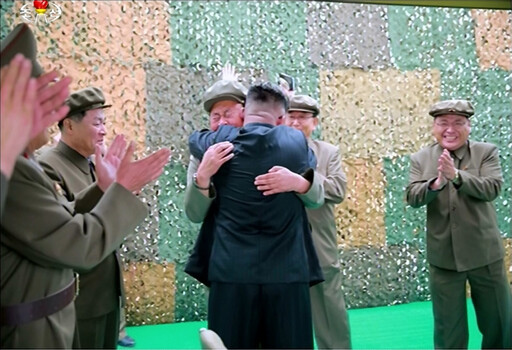hankyoreh
Links to other country sites 다른 나라 사이트 링크
With N. Korea’s Musudan progress, Seoul pulled further into US-Japan missile defense

South Korea is being drawn deeper into the US- and Japan-led missile defense system after North Korea’s June 22 test launch of the Musudan (Hwasong-10) missile, which revealed substantial development in intermediate-range ballistic missile technology.
Deliberations toward the deployment of a Terminal High Altitude Area Defense (THAAD) anti-missile system on the Korean Peninsula are also expected to gain momentum.
“[F]or whatever reason, and with whatever level of success, this [missile test] shows the need for us to continue to do what we're doing, which is build these missile defenses of various ranges to protect both our South Korean allies, US forces on the Korean Peninsula, Japan and US territory,” said US Secretary of Defense Ashton Carter in response to questions about the Musudan launch in a June 22 meeting with reporters at an army base in Fort Knox, Kentucky.
Carter’s specific references to “US forces on the Korean Peninsula” and “US territory” were particularly notable, as they suggest the US plans to beef up its missile defense to achieve its two goals in the Asia-Pacific region. Calls for a THAAD deployment as a first step now appear likely to grow louder. In the past, the US has cited the need to protect US Forces Korea and South Korea as reasons for the deployment. The recent Musudan launch appears to have substantially raised the likelihood that Washington will use it as grounds for pushing the THAAD deployment through over Beijing’s objections.
By “US territory,” Carter appears to have been referring to Guam. In the past, North Korea has deployed Scud B and C (Hwasong 5 and 6) missiles toward the Korean Peninsula and the Nodong ballistic missile toward Japan. With his remarks, Carter appeared to indicate the US’s plans to develop a means of intercepting the Musudan now that it has been developed as a potential means of striking Guam.
At the same time, Carter was somewhat dismissive of the chances that the Musudan test was actually a success.
“I don’t know whether it was successful,” he said.
A much clearer response came from Japan, which is exposed directly to the North Korean nuclear and missile threats.
“[The missile] flew for around 400 km and reached an altitude of over 1,000 km,” said Deputy Chief Cabinet Secretary Koichi Hagiuda during a regular press conference on June 23.
“This shows some level of intermediate-range ballistic missile capability. It is a serious concern for Japan’s security,” he added.
Hagiuda also said the progress in North Korean ballistic missile technology “is a fact that can’t easily be disputed,” adding that Tokyo “plans to work closely with the US, South Korea, and the other countries involves on a response.”
Some Japanese news outlets reported that Washington and Tokyo are now in a strategic corner where they have to develop a new means of interception for the Musudan. The Mainichi Shimbun newspaper quoted a Japanese Ministry of Defense official as saying he was “frankly astonished” that North Korea had launched a ballistic missile capable of reaching an altitude of over 1,000 km.
“There is a chance the rocket could be outside the firing range of the SM-3,” the official added, referring to the ballistic missile interception unit currently used on US and Japan Aegis-equipped warships.
The newspaper also said the ministry plans to speed up its work with the US on developing the new SM-3 Block IIA interception missile, which has a greater range.
Many fear that South Korea could find itself facing even greater pressure from both the US and Japan to join in their missile defense framework.
By Yi Yong-in and Gil Yun-hyung, Washington and Tokyo correspondents
Please direct questions or comments to [english@hani.co.kr]

Editorial・opinion
![[Column] Park Geun-hye déjà vu in Yoon Suk-yeol [Column] Park Geun-hye déjà vu in Yoon Suk-yeol](https://flexible.img.hani.co.kr/flexible/normal/500/300/imgdb/original/2024/0424/651713945113788.jpg) [Column] Park Geun-hye déjà vu in Yoon Suk-yeol
[Column] Park Geun-hye déjà vu in Yoon Suk-yeol![[Editorial] New weight of N. Korea’s nuclear threats makes dialogue all the more urgent [Editorial] New weight of N. Korea’s nuclear threats makes dialogue all the more urgent](https://flexible.img.hani.co.kr/flexible/normal/500/300/imgdb/original/2024/0424/7317139454662664.jpg) [Editorial] New weight of N. Korea’s nuclear threats makes dialogue all the more urgent
[Editorial] New weight of N. Korea’s nuclear threats makes dialogue all the more urgent- [Guest essay] The real reason Korea’s new right wants to dub Rhee a founding father
- [Column] ‘Choson’: Is it time we start referring to N. Korea in its own terms?
- [Editorial] Japan’s rewriting of history with Korea has gone too far
- [Column] The president’s questionable capacity for dialogue
- [Column] Are chaebol firms just pizza pies for families to divvy up as they please?
- [Column] Has Korea, too, crossed the Rubicon on China?
- [Correspondent’s column] In Japan’s alliance with US, echoes of its past alliances with UK
- [Editorial] Does Yoon think the Korean public is wrong?
Most viewed articles
- 1‘We must say no’: Seoul defense chief on Korean, USFK involvement in hypothetical Taiwan crisis
- 2N. Korean delegation’s trip to Iran shows how Pyongyang is leveraging ties with Moscow
- 3‘Weddingflation’ breaks the bank for Korean couples-to-be
- 4[Column] Park Geun-hye déjà vu in Yoon Suk-yeol
- 5Korea sees more deaths than births for 52nd consecutive month in February
- 6[Guest essay] The real reason Korea’s new right wants to dub Rhee a founding father
- 7[Column] The clock is ticking for Korea’s first lady
- 8[Column] Has Korea, too, crossed the Rubicon on China?
- 9Why Korea shouldn’t welcome Japan’s newly beefed up defense cooperation with US
- 10Will NewJeans end up collateral damage in internal feud at K-pop juggernaut Hybe?